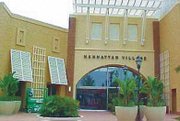Manhattan Village Gets a Beach-Themed Makeover
Overstuffed rattan chairs and couches fill the corridors. Light streams in through an overhead skylight in the central court. The interior colors are light and bright.
National retail real-estate company Madison Marquette is trying to brighten up the 20-year-old Manhattan Village Shopping Center in Manhattan Beach, Calif., by giving the enclosed mall a beach-like ambience.
Madison Marquette is putting the finishing touches on its new concept as it wraps up the second phase of its $50 million revitalization project, which will add about 15,000 square feet to the complex. The Cincinnati, Ohio-based firm bought 424,112 square feet of the 551,847-square-foot center in 2000, leaving the Macy’s store, which is owned by Federated Department Stores Inc. The mall was previously owned by Santa Monica, Calif.-based Macerich Company and AMB Institutional Realty Advisors Inc. It is located at 3200 Sepulveda Blvd., just blocks from the ocean.
When the second phase is completed this May, Tommy Bahamas will be the first to open its doors in an area that was once occupied by Tequila Willie’s restaurant.
Next in line will be LA Food Show, a restaurant concept being launched by California Pizza Kitchen co-founders Larry Flax and Rick Rosenfield. The 7,000-square-foot restaurant and bar will serve burgers, steaks and pasta but no pizza. The Manhattan Village eatery will be the first of the chain restaurants to open in the country.
A Corner Bakery will be the third retail outlet to occupy the reconstructed area.
Lease negotiations for two to three other spaces are in negotiations, said Margo Heltzel, director of marketing for the shopping center.
Madison Marquette is concentrating on creating a lifestyle center that will appeal to the affluent residents of Manhattan Beach, where average home prices run from $800,000 to $1 million. In the seaside community of 34,000 people, the median household income is $68,589. The nearby community of Hermosa Beach has an average household income of $100,755.
“I thought the mall had huge potential,” said Therese Byrne, a New York-based retail consultant who is also the editor and publisher of Retail Maxim, a monthly newsletter on retail and real estate.
Madison Marquette hired Byrne to study the mall before the firm purchased it for nearly $90 million. Byrne told the company it should play up the mall’s location near the ocean and attract the area’s well-todo customers.
Madison Marquette kept those wealthy customers in mind when it launched the first phase of its revitalization project in January 2002. The first improvements included new flooring, seating areas with rattan furniture and new mall entries. The new entrances, designed by Seattle-based Callison Architecture, replaced the two layers of glass doors that had formerly cast a dark spell over the mall. The new entrances are lighter and brighter with wooden awnings and gas-lamp replicas.
Much of the retail mix changed after the completion of the first renovation phase in June 2002.
The first babystyle store opened in the mall four months ago. Previously, the Los Angeles-based retailer had made its maternity and baby clothes available only on the Internet. But, with the opening of the Manhattan Village store, the company decided to go from clicks to bricks.
When announcing the new location last year, babystyle president and chief operating officer Tom Park said family-oriented Manhattan Beach, with its high-end wage earners, was the perfect location for the new venture.
Lucy, based in Portland, Ore., has been taking the same retail approach as babystyle. It started out in 1999 selling women’s workout gear via the Internet and now is branching out to bricks-and-mortar sites in upscale Californian communities, such as Santa Monica and Studio City. The company recently rolled out its third store at Manhattan Village.
Other retailers added during the first phase of renovation include Williams-Sonoma (which opened a 5,332-square-foot store last May), Chico’s, Talbots, Ann Taylor Loft, Pottery Barn, Pottery Barn Kids and White House/Black Market.
Gone, however, is most of the central food-court area. Tacone Cafeacute; is the only food vendor inside the mall’s central court.
“It was an under-performing area, drastically under-performing,” said Heltzel. “The landlord thought we could do better.”
While the shopping center has seen a new retail mix, sales have remained relatively flat. Currently sales average about $497 a square foot, up 1.5 percent from December 2001, Heltzel said.
Bruce Moe, finance director for Manhattan Beach, said that tax revenues from the mall have barely increased since Madison Marquette purchased the mall in September 2000.






















